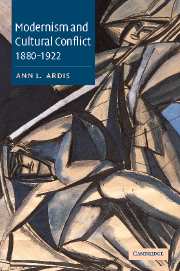Book contents
- Frontmatter
- Contents
- Acknowledgments
- Introduction: rethinking modernism, remapping the turn of the twentieth century
- 1 Beatrice Webb and the “serious” artist
- 2 Inventing literary tradition, ghosting Oscar Wilde and the Victorian fin de siècle
- 3 The Lost Girl, Tarr, and the “moment” of modernism
- 4 Mapping the middlebrow in Edwardian England
- 5 “Life is not composed of watertight compartments”: the New Age's critique of modernist literary specialization
- Conclusion: modernism and English studies in history
- Select bibliography
- Index
Introduction: rethinking modernism, remapping the turn of the twentieth century
Published online by Cambridge University Press: 22 September 2009
- Frontmatter
- Contents
- Acknowledgments
- Introduction: rethinking modernism, remapping the turn of the twentieth century
- 1 Beatrice Webb and the “serious” artist
- 2 Inventing literary tradition, ghosting Oscar Wilde and the Victorian fin de siècle
- 3 The Lost Girl, Tarr, and the “moment” of modernism
- 4 Mapping the middlebrow in Edwardian England
- 5 “Life is not composed of watertight compartments”: the New Age's critique of modernist literary specialization
- Conclusion: modernism and English studies in history
- Select bibliography
- Index
Summary
Rachel Vinrace, the heroine of Virginia Woolf's first novel, The Voyage Out (1915), reads “modern books, books in shiny yellow covers, books with a great deal of gilding on the back, which were tokens in her aunt's eyes of harsh wrangling and disputes about facts which had no such importance as the moderns claimed for them.” She reads Ibsen and George Meredith's Diana of the Crossways as well during her three-month stay in South America, but the narrator's physical and thematic characterization of this reading matter in Chapter Ten strongly suggests that she is reading fin-de-siècle British titles: Bodley Head publications such as John Lane's “Keynotes” fiction series, bound volumes of the Savoy with bold yellow covers and gilding on the covers and spines. Such texts were touchstones in the British debates about New Women, New Hellenism, and the cultural work of literature in the 1880s and 90s. Yet Rachel is encouraged by everyone she knows to read something else.
Her aunt, for example, encourages her to read “Defoe, Maupassant, or some spacious chronicle of family life” (130), and Mrs. Dalloway gives her Jane Austen. Her uncle allows her unlimited access to his library, while St. John Hirst lends her his copy of Gibbon's Decline and Fall of the Roman Empire, hoping thereby to begin the process of making up for her lack of a public school education and Oxbridge training.
- Type
- Chapter
- Information
- Modernism and Cultural Conflict, 1880–1922 , pp. 1 - 14Publisher: Cambridge University PressPrint publication year: 2002



